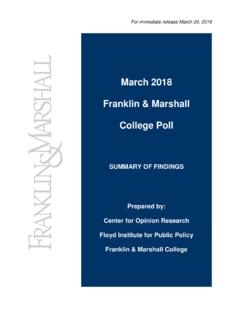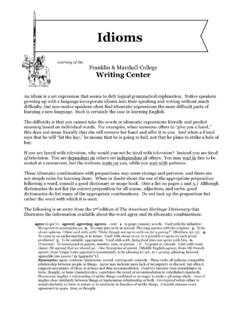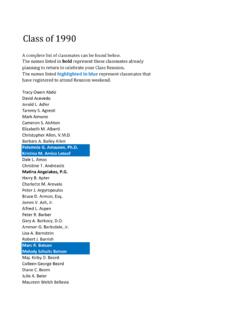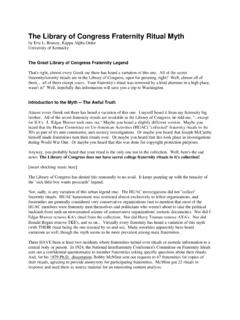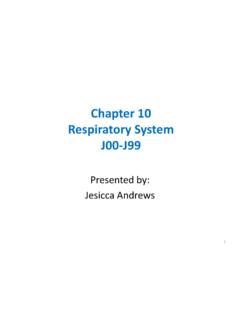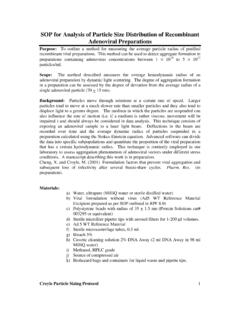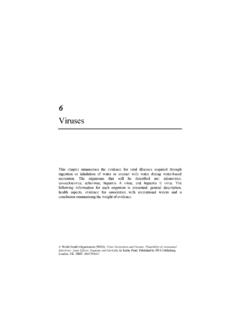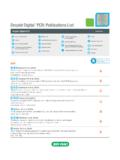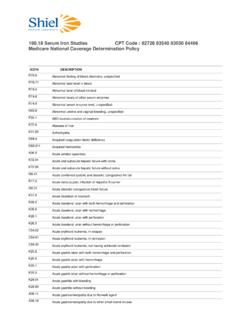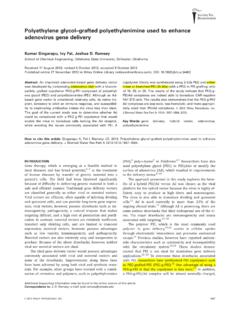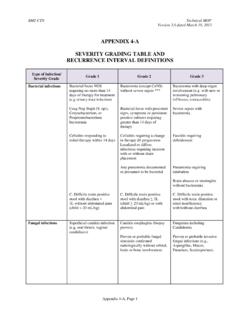Transcription of BiosafetyLevel2(BSL2)Training* - Franklin & Marshall
1 Biosafety Level 2 (BSL2) Training 1 BSL4 BSL3 BSL2 BSL1 High Hazard Low Hazard This training will help you to recognize poten<al hazards and reduce your risk. Think before you do anything What could possibly happen? What is the worst thing that could happen? What can I do to prevent it? What will I do if I can t prevent it? What is Biosafety? Biosafety is the applica@on of prac@ces and containment necessary to reduce the risks associated with biological hazards, such as poten@ally pathogenic organisms and toxic agents.
2 Biosafety describes the condi@ons under which such agents can be safely used to prevent the: release of poten@ally biohazardous agents to the environment exposure of lab personnel to poten@ally biohazardous agents 3 What is a Biological Safety Level ? A Biosafety Level can be assigned to laboratory work Each Biosafety Level describes the prac@ces and containment that will reduce the risk of exposure to poten@al biohazards. There are 4 levels of biosafety Level 1 represents the prac@ces and containment required for biohazards that pose the lowest hazard.
3 Level 4 is reserved for labs using materials that pose the greatest hazard. 4 BSL4 BSL3 BSL2 BSL1 High Hazard Low Hazard What is meant by each Biosafety Level Designa<on? What are the elements that determine a Biosafety level? The characteris@cs of the biohazardous material How the biohazardous material will be manipulated The primary protec@ve barriers and safety equipment The secondary protec@ve barriers or the facility design BSL4 BSL3 BSL2 BSL1 High Hazard Low Hazard All of these elements are considered during a risk assessment that is used to determine the biosafety level that will be applied to a lab.
4 Resources for Risk Assessment and Determina<on of Biological Safety Level In the , biosafety levels (BSL) are defined in two documents: 1. Biosafety in Microbiological and Biomedical Research Laboratories (the BMBL) from the Centers for Disease Control and Preven@on (CDC). 2. The NIH Guidelines for Research Involving Synthe@c and Recombinant Nucleic Acid Molecules (the NIH Guidelines) from the Na@onal Ins@tutes of Health (NIH). BSL4 BSL3 BSL2 BSL1 What is a BSL1 Lab? Biosafety Element Biosafety Level 1 Biosafety Level 2 Characteris<cs of the biohazardous material Not known to consistently cause disease in healthy adults Associated with human disease which is rarely serious and for which preven@ve or therapeu@c interven@ons are oXen available.
5 Planned manipula@ons Standard Microbiological Prac@ces BSL- 1 prac@ces plus Biosafety manual defining: Restricted access, Biohazard warning signs, Sharps precau@ons, Biowaste prac@ces, Medical surveillance & Spill Clean- up. Primary containment and protec@on PPE: gloves, lab coat and eye protec@on are used BSL- 1 protec@on plus: Physical containment for splashes/ aerosoliza@on; Biosafety Cabinets: aka @ssue culture hoods Facili@es design (secondary containment) Handwashing sink, emergency shower and eyewash, autoclave Same as BSL1 Biosafety level 1 is appropriate when agents that are generally not pathogenic are in use: E.
6 Coli Saccharomyces cerevisciae (or yeast) plasmid cloning vectors What is a BSL1 Lab? 8 Biosafety Element Biosafety Level 1 Biosafety Level 2 Characteris@cs of the biohazardous material Not known to consistently cause disease in healthy adults Associated with human disease which is rarely serious and for which preven@ve or therapeu@c interven@ons are oXen available. Planned manipula<ons Standard Microbiological Prac@ces BSL- 1 prac@ces plus Biosafety manual defining: Restricted access, Biohazard warning signs, Sharps precau@ons, Biowaste prac@ces, Medical surveillance & Spill Clean- up.
7 Primary containment and protec@on PPE: gloves, lab coat and eye protec@on are used BSL- 1 protec@on plus: Physical containment for splashes/ aerosoliza@on; Biosafety Cabinets: aka @ssue culture hoods Facili@es design (secondary containment) Handwashing sink, emergency shower and eyewash, autoclave Same as BSL1 Standard Microbiological Prac@ces should be observed. The prac@ces followed at higher biosafety levels are based on these standards. What are Standard Microbiological Prac<ces? Standard Microbiological Prac<ces Daily prac<ce of these ac<vi<es is cri<cal in every laboratory safety program: Wash hands aXer handling biologicals, taking off gloves and before leaving the lab.
8 No ea@ng, drinking, smoking, or applying cosme@cs in the lab. Wear clothing (sleeves, scarves, shoes, jewelry) appropriate to your tasks. Tie hair back. Use personal protec@ve equipment ( , lab gowns, coats, and gloves). Always use mechanical pipeang devices (never mouth pipebe). Decontaminate work surfaces daily and aXer spills. Avoid using hypodermic needles. Refer to the Sharps Handling and Disposal sec@on of your lab s Standard Opera@ng Procedure. Use procedures that minimize the forma@on of aerosols. Place all solid biological waste in red autoclavable bags for disposal.
9 Liquids must be disinfected before sink disposal. 9 What is a BSL1 Lab? 10 Biosafety Element Biosafety Level 1 Biosafety Level 2 Characteris@cs of the biohazardous material Not known to consistently cause disease in healthy adults Associated with human disease which is rarely serious and for which preven@ve or therapeu@c interven@ons are oXen available. Planned manipula@ons Standard Microbiological Prac@ces BSL- 1 prac@ces plus Biosafety manual defining: Restricted access, Biohazard warning signs, Sharps precau@ons, Biowaste prac@ces, Medical surveillance & Spill Clean- up.
10 Primary containment and protec<on PPE: gloves, lab coat and eye protec@on are used BSL- 1 protec@on plus: Physical containment for splashes/ aerosoliza@on; Biosafety Cabinets: aka @ssue culture hoods Facili<es design (secondary containment) Handwashing sink, emergency shower and eyewash, autoclave Same as BSL1 Primary Containment Gloves, lab coats and eye protec@on are used in BSL1 labs to protect workers Secondary Containment A hand washing sink, safety shower and eyewash sta@on must be available Biosafety Levels 2, 3 And 4 Build On The Prac<ces And Containment Required in BSL1 Labs BSL4 BSL3 BSL2 BSL1 High Hazard Low Hazard There are no BSL3 or BSL4 labs at F&M!
